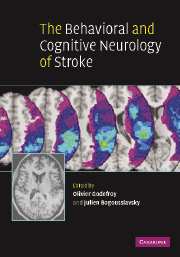Book contents
- Frontmatter
- Contents
- Contributors
- Preface
- 1 Evaluation of cognitive and behavioral disorders in the stroke unit
- Motor and gestural disorders
- Aphasia and arthric disorders
- Hemineglect, Anton–Babinski and right hemisphere syndromes
- Agnosia and Bálint's syndrome
- 14 Cortical blindness
- 15 Bálint's syndrome
- 16 Prosopagnosia
- 17 Object and color agnosia
- 18 Auditory disorders related to strokes
- Executive and memory disorders
- Behavioral and mood disorders
- Dementia and anatomical left/right syndromes
- Index
- References
14 - Cortical blindness
Published online by Cambridge University Press: 10 October 2009
- Frontmatter
- Contents
- Contributors
- Preface
- 1 Evaluation of cognitive and behavioral disorders in the stroke unit
- Motor and gestural disorders
- Aphasia and arthric disorders
- Hemineglect, Anton–Babinski and right hemisphere syndromes
- Agnosia and Bálint's syndrome
- 14 Cortical blindness
- 15 Bálint's syndrome
- 16 Prosopagnosia
- 17 Object and color agnosia
- 18 Auditory disorders related to strokes
- Executive and memory disorders
- Behavioral and mood disorders
- Dementia and anatomical left/right syndromes
- Index
- References
Summary
Introduction
Cortical blindness refers to a total loss of vision caused by a bilateral lesion or dysfunction of the occipital lobe. It represents a subset of cerebral blindness, a more general term which indicates blindness from any damage to both visual pathways posterior to the lateral geniculate bodies. Cortical blindness results typically from direct insult to both the primary visual areas lying in the calcarine cortex. As the responsible lesion does not usually limit to the cortex, but also encompasses the posterior part of the optic radiations and variably the extrastriate visual areas, both de-afferentation and de-efferentation of the primary visual cortex may also contribute to the visual dysfunction that is observed at the acute and at the recovered stages as well. Ischemic strokes are the major cause of cortical blindness.
Description
Clinical symptoms
By definition, cortical blindness is defined by a bilateral and total loss of vision. Thus, affected subjects can no longer identify visual forms, colors, location, orientation or movement of objects, nor even differentiate light from dark. They are usually distressfully aware of their deficit. At the acute stage, however, degree of awareness is variable. Patients may not report spontaneously their problem or seem indifferent to it. A minority of patients may even deny any visual loss or attribute their faulty performance to external factors, such as unfitted eyeglasses or poor room illumination.
- Type
- Chapter
- Information
- The Behavioral and Cognitive Neurology of Stroke , pp. 280 - 293Publisher: Cambridge University PressPrint publication year: 2007
References
- 1
- Cited by

